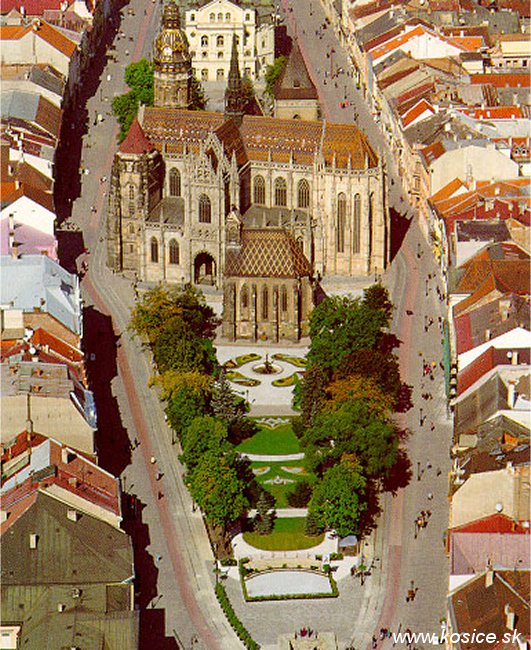 The town of Kosice was founded from the Slavic villages at Krasna nad Hornadom, where in 1143 the Benedictines abbey was consecrated. The first written mention of Kosice is in a document dated 1230 in the ancient document of Lubin. In 1249 the king Bela IV gave to the town the first privileges and in 1342 Kosice had the charter of a Free Royal Town. The king Ludwig of Anjou promoted Kosice to the second place in the hierarchy of the town directions of Hungary, only second after Buda. In 1369 Kosice received, as a first city in Europe, the town coat of arms. The coat of arms consists of of four red lines, four white lines and three lilies of Anjou royal family.
The town of Kosice was founded from the Slavic villages at Krasna nad Hornadom, where in 1143 the Benedictines abbey was consecrated. The first written mention of Kosice is in a document dated 1230 in the ancient document of Lubin. In 1249 the king Bela IV gave to the town the first privileges and in 1342 Kosice had the charter of a Free Royal Town. The king Ludwig of Anjou promoted Kosice to the second place in the hierarchy of the town directions of Hungary, only second after Buda. In 1369 Kosice received, as a first city in Europe, the town coat of arms. The coat of arms consists of of four red lines, four white lines and three lilies of Anjou royal family.
 In the first part of the 14th century there it was a large period of prosperity for the town. It began the construction of the St.Elizabeth's Cathedral, that was again rebuilded between 1378 and 1508, after the fire in 1357. The town was the center of the handicraft but also one of the metropoli of the European commerce. Towards the 1480 number of the inhabitants it was around 10,000 and to those times it was one of the greatest cities in Central Europe. In the 13 April 1556 a great fire destroyed almost the whole town, it damaged the churches, the monasteries, the town hall, the town walls. Thanks to the helps of the towns of Presov, Levoca and Bardejov the town of Kosice was rebuilded again.
In the first part of the 14th century there it was a large period of prosperity for the town. It began the construction of the St.Elizabeth's Cathedral, that was again rebuilded between 1378 and 1508, after the fire in 1357. The town was the center of the handicraft but also one of the metropoli of the European commerce. Towards the 1480 number of the inhabitants it was around 10,000 and to those times it was one of the greatest cities in Central Europe. In the 13 April 1556 a great fire destroyed almost the whole town, it damaged the churches, the monasteries, the town hall, the town walls. Thanks to the helps of the towns of Presov, Levoca and Bardejov the town of Kosice was rebuilded again.
During the 16th and 17th centuries the town of Kosice was marked from the rebellions against the Habsburgs and from the wars against the Turks, and the town knew a period of strongly economical decline and the commerce was paralized. From the 18th century were reconstructed many palaces and bourgeois houses in baroque style, and more late in classical and in art nouveau style. They had been built a big number of cloisters, houses, churches, the theater, the synagogue and the town extended themselves also to the of outside the city wall. A great number of building, convents, houses, churches, the theatre, synagogue and the extended city were constructed also outside of the town-walls.




